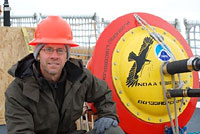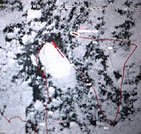

 | |||||||||||||||||||||||
|
|
Journals 2008/2009Steve Howard
August 27, 2008 Over breakfast this morning, there was a buzz going around about a team getting out on the ice today to deploy one of the ice buoys that I wrote about earlier in the journal (Monday, August 18). After many days of seafloor mapping, we were all excited about something new going on. It started with a briefing on the bridge, led by Coast Guard Operations Officer Jeff Stewart, in which all the logistics, safety considerations, and personnel who might be involved in the operation were discussed. I was, again, impressed by the seriousness and care with which all aspects of the mission were carefully considered. Any time you put people out on the ice you have dangers to consider, such as someone falling through the ice, polar bears, and the ship not being able to control its position while people are out there. Three of the scientists were chosen for this mission, plus a handful of Coast Guard personnel, based upon their experience and need to be involved.
After the briefing, everyone got busy. The buoy (which will gather data on temperature and barometric pressure as it drifts in the Arctic for three years) was lashed to a sled, the necessary tools were gathered, and the crane was put in position. Then... waiting. The ship had to move to a predetermined location, and there was some mapping work to do on the way. Then, we had to break into the ice flow, which took some time. By then, it was time for lunch, and the standard response to "when will they actually do this" was a tongue-in-cheek "sometime before nightfall" (remember, this is summer in the Arctic- it doesn't get dark here!). Finally, the ship was in position with all systems go. First, two Coast Guard people were lowered by crane onto the ice, one with a probe to make sure the ice would support the weight of the people and gear, a second with a gun to protect those on the ice from polar bear attack (if a bear was sighted, they would have scrapped the mission, pulling people out and respecting the bear's territory; shooting a bear would be a VERY last resort). Next, two scientists were lowered with an auger to drill a hole in the ice where the buoy would be secured. Finally, a third scientist and the buoy itself were lowered. The buoy was sledded over to the hole, set in place, and everyone and the gear was lifted out. All of the rest of us were out on the deck of the Healy snapping pictures and video like a bunch of paparazzi. I'm sure I wasn't the only one secretly wishing I could be out there on the ice walking around. Still, it was fun to watch and a nice change in the routine. There will be a second of these buoys that will be deployed in the coming days, which will more a more simple procedure of dropping it over the side into the water.
|
||||||||||||||||||||||




